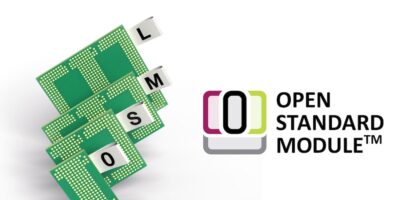SGET announces postage stamp CoM standard
Credit card sized embedded computer modules have a new footprint that reduces the size of a computer on module (COM) to a postage stamp. Technical consortium, SGET, has announced release 1.0 of the Open Standard Module (OSM) COM standard. OSM defines one of the first standards for directly solderable and scalable embedded computer modules.
The new specification aims to standardise the footprint and interface set of low-power application processors based on MCU32, Arm and x86 architectures across different sockets, manufacturers and architectures. Target applications of the new module standard include IoT-connected embedded, IoT, and edge systems that run open-source operating systems and are used in harsh industrial environments.
“OSM modules give ODMs and OEMs a miniature form factor with high scalability” explained Martin Unverdorben, chairman of the SGET STD.05 Standard Development Team. The modules are application-ready and supplied with all necessary software drivers and board support packages. The specification is open source, both in terms of the hardware and software, he added.
Like all CoM standards, OSMs simplify and accelerate the design-in of processors. At the same time, applications become processor-agnostic, which makes them scalable and future-proof, says SGET. They also protect NRE investments and extend the long-term availability, to increase RoI and sustainability of embedded systems. The OSM specification offers an extra level of ruggedness due to the BGA design and automated surface mount technology (SMT), which can further reduce production costs in series production, advises SGET.
OSMs are also published and licensed under Creative Commons Plus (CC+) dual license. This allows an open licensing model, such as the Creative Commons Attribution-ShareAlike license (CC B-SA 4.0) for a defined set of materials, components and software, and a commercial license for everything not included in this set. This ensures that development data, such as block diagrams, libraries and BOMs resulting from the development of OSMs, will be publicly available. It is also possible to license the IP of a carrier board design commercially without violating the open source idea.
The new OSM specification expands the portfolio of SGET module specifications with solderable BGA mini modules that are “significantly smaller” than previously available modules. The largest OSM measures 45 x 45mm, making it 28 per cent smaller than the µQseven module (40 x 70mm) and 51 per cent smaller than SMARC (82 x 50mm).
Other sizes are OSM Size-0 (30 x 15mm) with 188 BGA pins, OSM Size-S (30 x 30mm) with 332 pins, OSM Size-M (30 x 45mm) and 476 pins and Size-L (45 x 45mm) with 662 BGA pins. SMARC, by comparison, specifies 314 pins and Qseven 230. The BGA design makes it possible to implement significantly more interfaces on a smaller footprint, points out SGET, both in terms of miniaturisation and the increasing complexity of requirements.
The interfaces vary in type and design depending on the size of the OSM modules. Modules from Size-S upwards offer video interfaces for up to one RGB and four-channel DSI. Size-M modules can additionally support two eDP/eDP++, and Size-L adds an LVDS interface for graphics.
The OSM specification provisions up to five Ethernet for system-to-system communication. In addition, all modules have what is called a communication area, providing 18 pins for antenna signals for wireless communication or the integration of field buses. There are four USB 2.0 or two USB 3.0 (only in Size-L), up to two CAN, and four UART. Flash storage media can be connected via UFS. Up to 19 pins are available for manufacturer-specific signals. There are 39 general purpose I/Os, SPI, I2C, I2S, SDIO and two analogue inputs. Up to 58 pins are reserved for future purposes.




